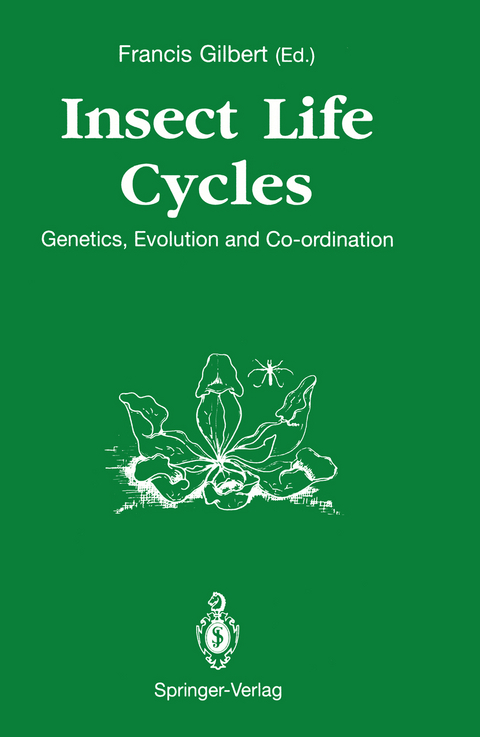
Insect Life Cycles
Springer London Ltd (Verlag)
978-1-4471-3466-4 (ISBN)
Section I. Genetics of Life-Cycle Traits.- 1 Understanding the Evolution of Insect Life-Cycles: The Role of Genetic Analysis.- 1.1 Introduction.- 1.2 Are the Predictions of the Two Approaches the Same?.- 1.3 Can Optimality Models Maintain Variation?.- 1.4 Does Phenotypic Variation Reflect Genetic Variation?.- 1.5 What Maintains Genetic Variation?.- 1.5.1 Environmental Heterogeneity.- 1.5.2 Antagonistic Pleiotropy.- 1.6 Concluding Comments.- 1.7 Summary.- 2 The Use of Selection to Probe Patterns of Pleiotropy in Fitness Characters.- 2.1 Introduction.- 2.2 Laboratory Natural Selection.- 2.2.1 Selection Procedures.- 2.2.2 Response to Laboratory Natural Selection for Later Reproduction.- 2.2.3 Response to Reversal of Laboratory Natural Selection.- 2.3 Artificial Truncation Selection.- 2.3.1 Selection Procedures.- 2.3.2 Direct Response to Artificial Selection.- 2.3.3 Indirect Response to Artificial Selection.- 2.4 Laboratory Culling.- 2.4.1 Selection Procedures.- 2.4.2 Response to Laboratory Culling.- 2.5 Comparison of the Selection Procedures.- 2.6 Patterns of Pleiotropy in Drosophila melanogaster Fitness Characters.- 2.6.1 What We Think We Know.- 2.6.2 What We Would Like to Know.- 2.7 Conclusions.- Section II. Evolution of Life-Cycle Traits.- 3 Evolution of Phenology and Demography in the Pitcher-Plant Mosquito, Wyeomyia smithii.- 3.1 Introduction.- 3.2 Life-Cycle of Wyeomyia smithii.- 3.3 Life-Cycle Traits and Geography.- 3.3.1 Predictions.- 3.3.2 Observed Phenological Traits.- 3.3.3 Observed Demographic Traits.- 3.4 Conclusions.- 4 Developmental Programmes and Adaptive Syndromes in Insect Life-Cycles.- 4.1 Introduction.- 4.2 Melanoplus sanguinipes.- 4.3 Gerris remigis.- 4.4 Oncopeltus fasciatus.- 4.5 Discussion.- 5 Coevolution Between Herbivorous Insects and Plants: Tempo and Orchestration.- 6 Size, Phylogeny, and Life-History in the Evolution of Feeding Specialization in Insect Predators.- 6.1 Introduction.- 6.2 Predictions.- 6.3 The Hoverflies (Diptera, Syrphidae).- 6.3.1 Species Considered.- 6.3.2 Data Used.- 6.4 Testing the Predictions.- 6.5 Discussion.- 7 Opportunistic Diapause in the Subtropical Ground Cricket, Dianemobius fascipes.- 7.1 Introduction.- 7.2 Ambiguity of the Subtropical Environment.- 7.3 The Subtropical Ground Cricket.- 7.4 Response to Temperature Rise.- 7.5 Response to Temperature Pulse.- 7.6 Stage Sensitive to High Temperature.- 7.7 Interacting Effect of Photoperiod and Temperature.- 7.8 Discussion.- 7.9 Summary.- 8 Evolution of Mutualistic Life-Cycles: Yucca Moths and Fig Wasps.- 8.1 Introduction.- 8.2 Natural History.- 8.3 Increasing the Probability of Association Between Host and Symbiont.- 8.3.1 Yuccas and Yucca Moths.- 8.3.2 Figs and Fig Wasps.- 8.4 Disruption of Mutualistic Life-Cycles.- 8.4.1 Figs and Fig Wasps.- 8.4.2 Yuccas and Yucca Moths.- 8.5 Conclusions.- 9 Testing Hypotheses About the Evolution of the Mean Phenotype in Temporally Variable Environments Fritz Taylor.- 9.1 Introduction.- 9.2 The Model.- 9.3 Results.- 9.3.1 Generation of Autocorrelation by Selection.- 9.3.2 Convergence of the Long-Term Phenotypic Mean.- 9.3.3 Convergence of the Standard Deviation of the Mean Phenotype.- 9.3.4 Convergence of the Long-Term Mean Phenotype.- 9.4 Discussion.- 9.5 Summary.- Section III. Coordination of Life-Cycle Traits.- 10 Insect Herbivores, Herbivory and Plant Succession Valerie K. Brown.- 10.1 Introduction.- 10.2 Insect Communities.- 10.2.1 Life-Cycle Strategies.- 10.3 Impact of Insect Herbivores.- 10.3.1 Community Effects.- 10.3.2 Comparative Studies.- 10.3.3 Effects of Insect Herbivores on Single Plant Species.- 10.4 Conclusions.- 11 Migration and the Coordination of Life-Cycles as Exemplified by Lygaeinae Bugs.- 11.1 Migration and Life-Histories.- 11.2 Three Steps in the Expression of Insect Migration by Flight.- 11.3 Within-Species Variation - Horvathiolus gibbicollis.- 11.4 Between-Species Comparisons.- 11.5 Conclusions.- 11.6 Summary.- 12 Competition and Selection in a Patchy and Ephemeral Habitat: The Implications for Insect Life-Cycles.- 12.1 Introduction.- 12.2 Competition.- 12.3 Selection.- 12.4 Implications.- 13 Facultative and Obligatory Diapause Responses in Three Species of Burnet Moth: A Characterization of Life-Cycle Phenologies by Field Observations and Laboratory Experiments.- 13.1 Introduction.- 13.2 Geographical Distribution of the Burnet Moth.- 13.3 Partivoltinism in the Burnet Moth.- 13.4 A Case of a Bivoltine Population?.- 13.5 Conclusions.- 13.5.1 Adaptive Significance of Repeated Diapauses in Northern Populations.- 13.5.2 Phenology, Synchrony and Voltinism at Southern Study Sites.- 14 The Present and Future of Insect Life-Cycle Evolution.- 14.1 Introduction.- 14.2 Maintenance of Genetic Variability for Fitness Traits.- 14.3 The Genetic Connection in Life-History Syndromes.- 14.4 Emergent Life-Cycle Patterns.- 14.5 Where Do We Go From Here?.- Species Index.
| Zusatzinfo | 107 Illustrations, black and white; XIV, 258 p. 107 illus. |
|---|---|
| Verlagsort | England |
| Sprache | englisch |
| Maße | 170 x 244 mm |
| Gewicht | 482 g |
| Themenwelt | Naturwissenschaften ► Biologie ► Botanik |
| Naturwissenschaften ► Biologie ► Ökologie / Naturschutz | |
| Naturwissenschaften ► Biologie ► Zellbiologie | |
| Naturwissenschaften ► Biologie ► Zoologie | |
| ISBN-10 | 1-4471-3466-4 / 1447134664 |
| ISBN-13 | 978-1-4471-3466-4 / 9781447134664 |
| Zustand | Neuware |
| Haben Sie eine Frage zum Produkt? |
aus dem Bereich


